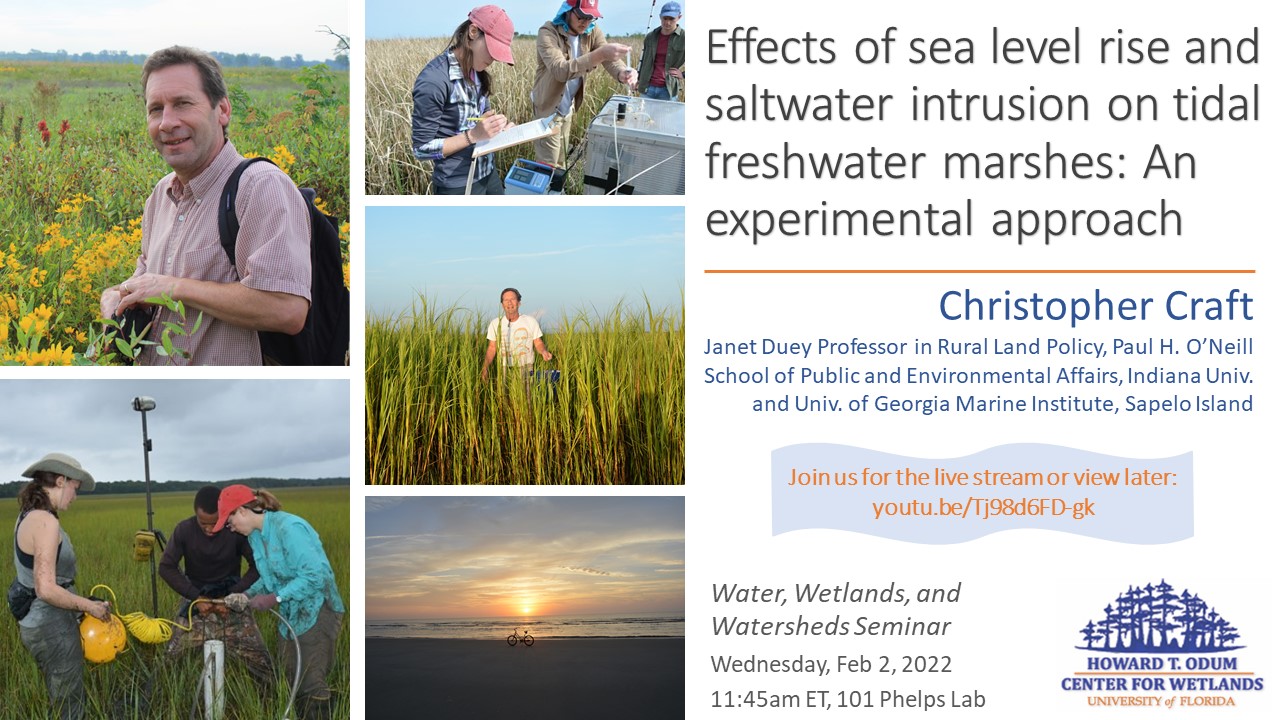Effects of sea level rise and saltwater intrusion on tidal freshwater marshes: An experimental approach
Christopher Craft, Janet Duey Professor in Rural Land Policy, Paul H. O’Neill School of Public and Environmental Affairs, Indiana University; and University of Georgia Marine Institute, Sapelo Island
Join us for the live stream Feb 2, 11:45am EST: https://youtu.be/Tj98d6FD-gk
(Please visit our youtube channel main page for the stream if there are any issues with the direct link.)
ABSTRACT
Tidal freshwater marshes (TFMs) are threatened by seawater intrusion caused by climate change and rising seas, which can adversely affect nutrient and carbon cycling and storage, ecosystem productivity, and soil microbial communities. We conducted a long-term (3.5 years), large-scale manipulative field experiment (Seawater Addition Long Term Experiment, SALTEx) to investigate the effects of continuous (press) and episodic (pulse, 2 months per year) inputs of brackish water to a TFM on the Altamaha River, GA. Continuous seawater additions increased porewater salinity (3-5 ppt), inorganic nitrogen (nitrate, ammonium), phosphate, and hydrogen sulfide. Plant productivity, both aboveground and belowground, along with species richness decreased in response to press salinity. Ludwigia disappeared immediately while Polygonum disappeared 6 months after press salinity treatments began. Species such as Pontederia and Zizaniopsis also decreased over a longer time frame (~1 year), though they did not completely disappear. The decline in vegetation cover and productivity led to reduced net ecosystem exchange, including depressed CO2 and CH4 emissions. Further, the decline in plant productivity, especially belowground biomass, resulted in a loss of soil elevation of 2.8 cm leading to a reduction in carbon storage of 770 g/m2 over 3.5 years. Finally, press salinity decreased soil microbial diversity and altered community composition that was attributed to decreased macrophyte carbon inputs. Episodic seawater intrusion, while temporarily increasing porewater salinity, did not lead to significant changes in nutrient or carbon cycling, ecosystem productivity, or microbial diversity. Vegetation cover also was little affected by pulse salinity, though there was a significant decline in Ludwigia within six months after the pulse seawater treatments began. Taken together, results from these studies show that continuous seawater intrusion reduces the ability of TFMs to build elevation and keep pace with rising sea levels while also diminishing their ability to provide ecosystem services such as water quality improvement, carbon storage and biodiversity.
Bio
Christopher Craft is Janet Duey Professor of Rural Land Policy at Indiana University, Bloomington. Along with 38 years of experience working in wetlands, Professor Craft is author of Creating and Restoring Wetlands: From Theory to Practice, and co-editor of Wetland Soils: Hydrology, Landscapes, and Classification with Michael Vepraskas. He is Past President (2008-2009) of the Society of Wetland Scientists and recipient (2012) of the National Wetlands Award for Science Research presented by the Environmental Law Institute, Washington D.C.
POSTCARD

